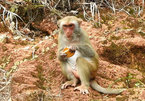“Only 70-100 elephantd still exist. As for wild tiger, there are only five. Bear, pangolin and sao la are facing the risk of extinction,” said Nguyen Thi Van Anh from the Department of Nature Conservation and Biodiversity.

The figures show that wild animals in Vietnam are in danger and declining. According to the Red Book International Union for Conservation of Nature (IUCN) updated in July 2019, Vietnam has 700 species in danger at the VU (vulnerable) level or higher, including 57 species of mammals, 52 birds, 71 reptiles, 45 amphibians and 85 species of fish.
The major cause is overexploitation of natural resources, including wild animals.
Rhino horn is consider a panacea for hundreds of kinds of diseases, elephant ivory is used as decoration, bears are hunted and bred in captivity for gall, while pangolin and birds are secialty food favored by people.
| Rhino horn is consider a panacea for hundreds of kinds of diseases, elephant ivory is used as decoration, bears are hunted and bred in captivity for gall, while pangolin and birds are secialty food favored by people. |
“It is the demand from people who are willing to pay to buy luxury products made of wild animals which has promoted the trafficking of wildlife,” Anh said.
According to the General Directorate of Environment, in 2015-2017, agencies seized and handled 315 violations with 271 subjects related to wildlife. Of these, 111 defendants in 74 cases faced criminal charges. However, experts believe that the figures account for 5-10 percent of the number of actual cases.
Meanwhile, Education of Vietnam (ENV) reported that three violations related to wildlife occur every day. In the first six months of 2019 alone, 729 cases were discovered.
Tigers, elephants, rhinos, pangolins, sea turtles, freshwater turtles and primates are the most affected.
Vietnam has been classified by the US Agency for International Development (USAID) as a transshipment and consumption point for rhino, elephant ivory and pangolin.
As one of the countries with the richest biodiversity in the world, it faces the decline and degradation of wildlife and plants.
Vietnam is a member of many international conventions on species and biodiversity conservation such as Convention on Biological Diversity (CBD 1994), Ramsar Convention 1989, Convention on International Trade in Endangered Species of Wild Fauna and Flora (CITES 1994) and United Nations Convention to Combat Desertification (UNCCD 1998).
However, these efforts "are still not enough to to reverse the trend of species decline,” said Hoang Thi Thanh Nhan, Deputy Director of Department of Nature Conservation and Biodiversity, adding that more efforts to protect endangered species are essential.
Mai Lan

Tourists asked not to feed wildlife on Son Tra Peninsula
Authorities in the central city of Da Nang have warned tourists not to feed local monkeys, the Vietnam News Agency.

Hanoi authorities confiscate illegal wildlife products
Fifty-five pieces of rhino horn weighing 125.15kg were discovered hidden in plaster at Noi Bai International Airport recently, Hanoi Customs have announced.
 Vietnam remains a hot spot for wildlife hunting and trafficking despite efforts to curtail it.
Vietnam remains a hot spot for wildlife hunting and trafficking despite efforts to curtail it.